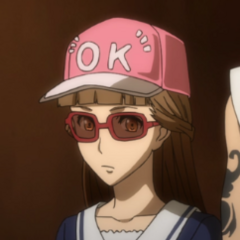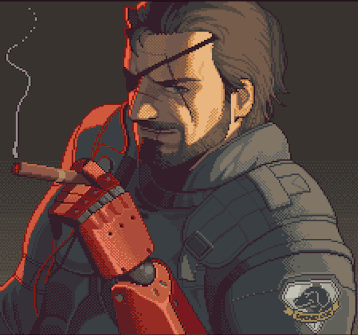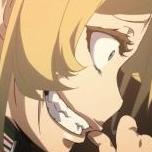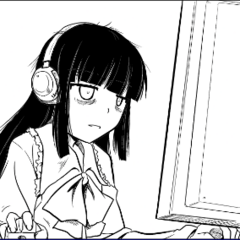-
Posts
6542 -
Joined
-
Last visited
-
Days Won
172
Clephas last won the day on July 23
Clephas had the most liked content!
About Clephas

- Birthday 02/24/1982
Profile Information
-
Gender
Male
-
Location
ERROR, ERROR, FAILURE TO OBTAIN CONCLUSIVE DATA
-
Interests
VNs, anthropology, writing, reading, translation, anime, video games, sharp things, firearms
-
Japanese language
High
-
Development skill
Translator
Otaku Web
-
Visual Novel Database (VNDB)
10917
Contact
-
Website
http://clephasstomach.blogspot.com/?zx=719f8f42705b40c5
Recent Profile Visitors
Clephas's Achievements

Fuwa Master (10/11)
3.9k
Reputation
-
 Pallas_Raven reacted to a comment on a blog entry:
The Grisaia Trilogy Review – Fruits of Many Flavours
Pallas_Raven reacted to a comment on a blog entry:
The Grisaia Trilogy Review – Fruits of Many Flavours
-

The Grisaia Trilogy Review – Fruits of Many Flavours
Clephas commented on Pallas_Raven's blog entry in Towards The End Sky
Oh, you also mention characters acting oddly to make the story progress, but this is fairly common in plot-focused VNs. In early VNs, it was mostly because of the philosophy of 'gotsugoushugi', which is a game-maker philosophy for plot-focused games with multiple routes where character actions and even personalities are warped at a moment's notice solely to move the story forward. The real issue is a matter of degree. For instance, there are a number of VNs I can think of off the top of my head where the personality change of a main character was so dramatic it completely broke me out of my engrossment in the story. The most egregious example of this I can name right here and now is Tsuki ni Yorisou Otome no Sahou 2. During the common route of the game, the protagonist is an arrogant, immensely capable person with a wide variety of talents, but in each of the heroine routes, his personality gets toned down, his talents weakened, and his motivations twisted in ways that don't make sense even in the context of the route. This is an example of going too far with that kind of tactic. More subtle are the random bad endings that pop up in a lot of horror and action VNs (especially early ones) where the actual choices result in random horrible deaths that make absolutely no sense in the chronology of the story. These games were the reason I started resulting to using walkthroughs for all VNs, because I got tired of making choices, only to end up with senseless bad ends or normal just friends endings. However, at the same time, this degree of manipulation can actually result in a positive result, as while those endings were often frustrating, they were also part of the experience as a whole and made it richer in some way. To be honest, it is one of those JVN storytelling techniques that can be either excellent or horrible depending on how well it is utilized. -
 Pallas_Raven reacted to a comment on a blog entry:
The Grisaia Trilogy Review – Fruits of Many Flavours
Pallas_Raven reacted to a comment on a blog entry:
The Grisaia Trilogy Review – Fruits of Many Flavours
-

The Grisaia Trilogy Review – Fruits of Many Flavours
Clephas commented on Pallas_Raven's blog entry in Towards The End Sky
This isn't the only VN series that organically turned into a trilogy or a duology. A perfect example is Akatsuki no Goei. It has an almost identical approach to continuing things to Grisaia, in that the second game is a combination of after-stories and a route that covers the protagonist's past (which is incidentally even more brutal than Yuuji's). The big difference is in the third game, which is based off of the Kaoru route of the first game (non-romantic route). While it has a core story, it has three main routes and numerous heroines, the big change mostly being in what perspective the protagonist sees the story from. As an approach, it has its positives and negatives. Kinugasa Shougo, the writer for Akatsuki no Goei, hates conclusive endings, and it is pretty evident that Shangri-la (later absorbed by Akabei) forced him to conclusively end the main series in Tsumibukaki Shuumatsuron. His resentment came out in spreading the reader's attention across way too many heroines, in my opinion. Grisaia came out later, so I always figured that they learned from the excesses of the Akagoei trilogy when they made Grisaia into a trilogy, focusing on the cast of characters rather than expanding it massively. -
 Nandemonai reacted to a post in a topic:
How do I access unofficially translated visual novels?
Nandemonai reacted to a post in a topic:
How do I access unofficially translated visual novels?
-

Hapymaher - 7.8/10 - Entertaining mystery / nakige
Clephas commented on LostPomegranate's blog entry in LostPomegranate's Reviews and Recommendations
Hapymaher's is a nakige, by genre, a game where the entire point of the story is to make you cry. The mystery elements are secondary. The most impressive parts of this VN besides the quality of the feels are the quality of the soundtrack and the genius with which it is utilized. To be blunt, there literally haven't been any VNs since it that have had such an excellent soundtrack that was also used so perfectly. The character designs are also unique and high-quality, if a bit overly influenced by Alice in Wonderland. As for routes, Yayoi's, Saki's, and Keiko's routes are interchangeable for order, so there isn't really a recommended order for them, at least in my experience. It is pretty much required that Alice's path be right before the true end, though. It is possible not to do the normal or bad end at all if you don't want to. -
 Pallas_Raven reacted to a comment on a blog entry:
Timed Choices – An Anatomy of Visual Novels
Pallas_Raven reacted to a comment on a blog entry:
Timed Choices – An Anatomy of Visual Novels
-

Timed Choices – An Anatomy of Visual Novels
Clephas commented on Pallas_Raven's blog entry in Towards The End Sky
I never liked timed choices as a mechanism in VNs... most of the time, they were just annoying. I guess it is because if I wanted to feel pressured, I would just go play a normal video game like a shooter or an a Souls-like game. -

Anime of the Year 2020-I Winter - Infinite Dendrogram
Clephas commented on kivandopulus's blog entry in Anime of the Season
Infinite Dendogram- It's been a while since Kvan and I have agreed on an anime, but this is one of those times. I don't understand why people bash this one so much... Bofuri- Overpowered iyashikei at its best. Tennen main character becomes overpowered through random silly actions like eating her enemies while they can't penetrate her defenses. -
 MDruidd reacted to a post in a topic:
Looking for a heroine in opposition to the MC
MDruidd reacted to a post in a topic:
Looking for a heroine in opposition to the MC
-

Looking for a heroine in opposition to the MC
Clephas replied to freshgyoza's topic in Recommendations
Translated Dies Irae (Kei) Dies Irae Interview with Kaziklu Bey Ayakashibito (Kaoru) Untranslated Kikan Bakumatsu Ibun Last Cavalier (Iori and Tokio) Akatsuki no Goei 3 (Mai, Akemi, Kiyomi, Kanako, Kaede) Vermillion Bind of Blood (Ariya) Yurikago yori Tenshi Made (Aria) Zero Infinity (Eliza) Abyss Homicide Club (Kotoko and Yuu) Blade x Bullet (all of them) Gekkou no Carnevale (all but Anna) Gleam Garden no Shoujo (Luna) Shinigami no Testament (Irina) -

Anime of the Year 2019-III Summer - Ling Long: Incarnation
Clephas commented on kivandopulus's blog entry in Anime of the Season
Arifureta Shokugyou- An example of how an awful anime can come from a top-class light novel. The two biggest flaws of this anime are that too many episodes are spent on the labyrinth (basically the prologue) and the decision to use 2.5D animation for some of the monsters. The results were that some of the monsters just look off and don't match with the basic animation, thus making the combat less interesting than it could be. I recommend just reading the light novels instead. Isekai Cheat Magician- Extremely low-quality isekai. Cop Craft- A top-quality anime about a version of Earth where a fantasy world was connected to Earth through a gate, causing a massive war. The protagonist is a detective with a history as a veteran and the main heroine is an aristocrat from the other side of the gate. Katsute Kami Datta Kemono Tachi- A fantasy series focusing on a group of soldiers experimented on and turned into weapons of war. As time went by, they lost their humanity and now the last sane member is hunting them down. Maou-sama, Retry- This particular season's guilty pleasure for me, because the setting and story are all over the place. However, it is fun to watch, especially because of how it constantly mocks isekai tropes. El-Melloi Case Files Season 2- Normally I wouldn't bother mentioning this, but I love El-Melloi Case Files, lol. Uchimusume- An interesting variation on the Japanese-style high fantasy world. The world has multiple 'maous' and the mazoku are just another race. The protagonist is an adventurer who finds an exiled mazoku child in the forest by the skeletal body of her father. He brings her back to civilization and raises her as his own. Much of the story is tear-jerking or adorable (sometimes both) with the little girl jerking on your heart strings and just being an adorable little girl in general. There is some action to the series, and what is there is pretty good. However, it isn't a focus. Vinland Saga- Historical fantasy/drama focused on the era when the British Isles were colonized forcibly by the Danes. Extremely violent and bloody. Sounan Desu ka- A weird little anime about a group of girls who get stranded on a desert island. I recall it being weirdly fascinating to watch. Kawaikereba Hentai demo Suki ni Natte Kuremasu ka?- This anime is a comedy about a harem protagonist who is followed around by a bunch of perverted girls (all of them different types). It is generally a fun watch, but it isn't something to go back to again later once you've finished it. -
I could list a lot more, but these came to mind more or less immediately. https://vndb.org/v3671 https://vndb.org/v18842 https://vndb.org/v10957 https://vndb.org/v10958 https://vndb.org/v370 https://vndb.org/v1335
-
 rimvydasm reacted to a post in a topic:
How do I access unofficially translated visual novels?
rimvydasm reacted to a post in a topic:
How do I access unofficially translated visual novels?
-

help please help me to find Kusairo no hitomi eroge
Clephas replied to Stephaniiia's topic in Visual Novel Talk
Unfortunately, it is no longer available. This is no surprise, since it is from before the turn of the century and was likely never redone in a digital format. Also, please remember to put NSFW pics and borderline ones inside of spoiler boxes with NSFW warnings above. -
-
 Dreamysyu reacted to a post in a topic:
How do I access unofficially translated visual novels?
Dreamysyu reacted to a post in a topic:
How do I access unofficially translated visual novels?
-
 Entai2965 reacted to a post in a topic:
How do I access unofficially translated visual novels?
Entai2965 reacted to a post in a topic:
How do I access unofficially translated visual novels?
-

discussion How do I access unofficially translated visual novels?
Clephas replied to NadiaEros's topic in Visual Novel Talk
90% of the patches (from 2005-2018) were done entirely through manual translation with mtl only being used for individual words. This was because it was only recently that some MTL apps/sites/etc could actually translate a complete sentence from Japanese to English coherently. Even now, they can't handle proverbs, colloquialisms, and slang/local dialects, so they are only used for 'rough' first-day patches, mostly on indie VNs. Edit: The reason I feel a need to mention this is because these people put a ton of work into something that didn't get them anything but prestige and has mostly been forgotten in the years since. This is literally hundreds or even thousands of hours of work in some cases, done in people's free time. While some of these fan patches were later purchased by localization companies and retooled for localization, there are still a number of games where my statement still applies. -

Clephas Japanese Web Novel Recommendations (Sci-fi, fantasy, and isekai)
Clephas posted a blog entry in Clephas' VN home
I've been devouring web novels for some time now, so I have a pretty wide experience (within my preferred genres). My preferences probably won't match many of yours, but I figured I would make some recommendations like I used to with visual novels. Isekai'd+Overpowered/cheat protagonist Death March Kara Hajimaru Isekai Kyousoukoku (https://ncode.syosetu.com/n9902bn/)- Despite the anime being a flop, this is easily one of the best fantasy web novel series of the type. In addition, the LN version differs so greatly from the web novel that you can actually enjoy them completely separately from one another, which makes them double the fun. Arifureta Shokugyou de Sekai Saikyou (https://ncode.syosetu.com/n8611bv/)- Yes, the anime was mostly crap (except for Yue being a vampire goddess), but the web novel is awesome. It was also something of a trendsetter, setting the gold standard for the 'betrayed protagonist rises to be the strongest' trope. The web novel has a huge advantage over the light novel series in that the after-story (which is now longer than the original story) is godly and immensely fun to read. My Classmates were Summoned to Another World but I was Reincarnated (https://kakuyomu.jp/works/16816452221074480581)- Basically, the protagonist dies during the summoning and gets reincarnated as a true vampire by the ditzy goddess of the world her classmates were summoned to and goes on a self-indulgent journey/adventure/rampage across the surface of the other world. The protagonist is definitely chaotic neutral in personality, though her actions often split off into chaotic good and chaotic evil depending on who she is dealing with. For people who want to laugh at a protagonist's absolutely insane antics, this is a good choice. Isekai ni Houchi-ge Riron o Mochikondara Isekai Saikyou ni Nareru Isetsu (https://kakuyomu.jp/works/16817330652291194063)- Basically a gamer gets reborn into a rather harsh and massive fantasy isekai, where he uses sorcery to create autonomous spells that go around killing monsters so he can level up faster. He is a leveling addict and this story, like most of this author's stories, is full of insane characters (including the protagonist and heroine). This is one of the few male protagonist WN series I've met that doesn't include a harem. Toriaezu Shinu Wa (https://kakuyomu.jp/works/16816700427424058338)- Made by the same author as Houchi-ge, it was his pilot work. It is complete (this author follows through and consistently posts his works, so you don't need to worry about fade-outs), so you can just dive in and read from the beginning to the end. In this one, the protagonist and his class get summoned to another world, and when he finds out some of his nastier classmates intend to assassinate him, he uses the plot to get out of town (faking his death) and gain his freedom. This one is pretty dark, the protagonist actively committing genocide and purges against religion (though the religion deserves it), and his girlfriend is a psychotic yandere who is incapable of empathy for anyone but him. However, the character personalities in this one are really well presented, which matches this author's style. Paradigm Parasite (https://kakuyomu.jp/works/1177354054891938248)- Protagonist is reborn as a parasite that possesses the corpse of a young noble and proceeds to rampage across the psychotic isekai he ended up in. He is utterly cold-blooded, pragmatic, and predatory by nature. This is a pure chaotic evil protagonist acting on his worst instincts throughout much of the story. Isekai'd+Adventurer/Not overpowered Jiriki de Isekai he! (https://kakuyomu.jp/works/1177354054941828435)- By coincidence, the protagonist manages to create a magic circle that transports him to another world... by killing him. The god who greets him informs him that his actions count as suicide, thus he won't be granted any special rewards. He is reborn as an orphan and regains his memories by accident, his skill (not a cheat skill) activating for the first time as a result of a near-death experience. He sets out to become an adventurer, living his isekai life as best he can. This series is complete, so you can just dive in and read it from beginning to end. Karyoku no Nai Kaze Mahoutsukai wa, Isekai nite Ken de Mau (https://kakuyomu.jp/works/16817330652107435856)- An excellent story for those who want a reincarnated protagonist who isn't overpowered and lives his life as an adventurer. The protagonist is half-halfling, half-giant in a world that is a half-step away from the age of mythology. Annainin wa Isekai no Jukai o Samayou (https://kakuyomu.jp/works/1177354054918935123)- Protagonist falls through a gate to another world and is forced to become an adventurer in order to survive. Eventually, he is able to return to Earth and becomes a 'guide', teaching people how to survive on the other world. Modern Fantasy/dungeons (sometimes with an isekai'd then returned protagonist) Isekai Kara Kikan Shitara Chikyuu ga Fantasy Deshita. Ato, Make Heroine domo, Kocchi Minna (https://kakuyomu.jp/works/16817330650225915619)- This one focuses on a protagonist who succeeds in killing the evil god in another world and returns to earth, only to once again face his childhood friend presenting his newest lover to him with a victorious expression. However, he doesn't care at all, as he is finally free of the hell of the other world! (He really, really hates the isekai). This series is mostly humorous as Nacchan's manic personality and immense power meets Earth's fantasy beings in clashes that are usually disastrous for the fantasy beings. Shachiku Kensei, Haishinsha ni Naru (https://kakuyomu.jp/works/16817330657186803576)- Mix of dark humor and overpowered action as a guy in a business suit explores the depths of dungeons. It is updated irregularly but even just what is there so far is worth reading. Seikatsu Mahoutsukai no Gekokujou (https://kakuyomu.jp/works/16816452218254294002)- Oppressed protagonist with a gift for the weakest school of magic discovers the sage system for his school of magic and develops it for combat, eventually becoming a famous dungeon crawler and magic developer. Series is complete and the battles are pretty cool. While technically the protagonist is overpowered, that is because he works hard at it and discovers ways to deal with the situations he encounters. Maou o Taoshite Gendai ni Kaetekitara Parallel World Deshita! (https://kakuyomu.jp/works/1177354054888599901)- An overpowered isekai protagonist returns to earth with his divine fox lover, only to find that he returned to a parallel world where dungeons emerged during WWII. The story is mostly ecchi+action+people being people. The series is complete. Onmyouji/Youkai/Modern Fantasy Gendai Onmyouji wa Tensei Lead de Musou Suru (https://kakuyomu.jp/works/16816927863187332284)- The protagonist is reborn into a version of Japan where youkai and onmyouji are still at war with one another and uses his self-awareness to prepare for his future by building up his power young. Pretty fun to read, still ongoing if slowly so. Inousha ga Futsuu ni Iru Sekai he Tensei Shitara (https://kakuyomu.jp/works/16816452218603293395)- Protagonist is reborn into what he thinks is a game world in the body of a villain who does pretty horrible things to most of the heroines. This series is pretty dark, and it becomes evident (through other perspectives) that this isn't actually a game world early on. The protagonist is technically overpowered, but so are a lot of the enemies and one of the main heroines. It shows the dark and hard sides of harems and political marriages as well, so for people who want a 'happy harem' story, this isn't a good choice. Demon Ruler (https://kakuyomu.jp/works/1177354054882154317)- Salaryman protagonist gains access to pocket dimensions where he can take out his daily stress on real monsters and gain money and power. Quite naturally, he enthusiastically dives into his new hobby. Fun to read, gets more apocalyptic after a while. Anata no Tenshoku wa 'Daiyoukai' Desu (https://ncode.syosetu.com/n2559fp/)- One of my all-time favorites. The protagonist lives in a future where humanity's population once fell to critical levels and only recovered through the use of the 'oracle' system, which tells people their ideal occupations. When he uses it, it tells him his ideal occupation is being 'a great youkai', and he is introduced to the real reason why the system exists... to balance the supernatural with the natural. The protagonist is more than a little crazy, his adopted mother is Tamamo no Mae, his adopted father is Shuten-doji, and his adopted grandfather is Sojou-bou (he is actually descended from all three). This series has a lot of dark laughter, interesting action, and a few moments that will have you weeping until snot flows out of your nose. Too bad this author's other works are sub-par at best, lol. Fantasy, not from Earth Kami-sama ni Muriyari Ikikaesareta (https://kakuyomu.jp/works/16816452220822010394)- This begins as the sad tale of a young orphan boy (recently deceased saving a little girl from a wolf) faces the goddess who broke her promise and failed to protect his mother and himself. As a result, she tries to revive him, but he demands that he be allowed to die, drawing the attention of higher beings, starting a series of events that eventually results in him being granted access to all class skills and resurrected with two divine guardians. This is not a tale of a guy doing whatever the hell he wants and making a mess of the world. Rather, it is the tale of a boy who has suffered so much he no longer reacts to the little pains and reacts to others with cold rationality, ignoring most of the social rules in the process. The protagonist is rather wordy when he thinks someone is doing something wrong, and he has no hesitation about confronting people with it. Kurotobi no Seija (https://ncode.syosetu.com/n9105fz/)- Cleric makes a deal with a dark god for power to get back at those who exiled him. Decent read for those who don't want an Earthling protagonist. -

My visual novels are having gobbledygook text files
Clephas replied to TheSoaringDingo's topic in Visual Novel Talk
Sorry, but playing non-localized JVNs, especially old ones, pretty much requires the locale change. I'm surprised it even starts on a Mac, given the lack of emphasis on compatibility towards Mac computers in the JVN industry. My suggestion is to use a sandbox app and put Japanese Windows or English Windows on it, then install the game there. Sorry to say that that is the only workaround I can think of at the moment. -

My visual novels are having gobbledygook text files
Clephas replied to TheSoaringDingo's topic in Visual Novel Talk
A few questions: Is it the PC version? If so, did you set you system locale and region format to Japan and Japanese format? (This is required for a lot of JVNs, and it can be done by using the search bar to look for the control panel and clicking on 'region') If it is the console version, I can't help.













.thumb.jpg.4043f9b65e5a46c381517ac98f99028f.jpg)




